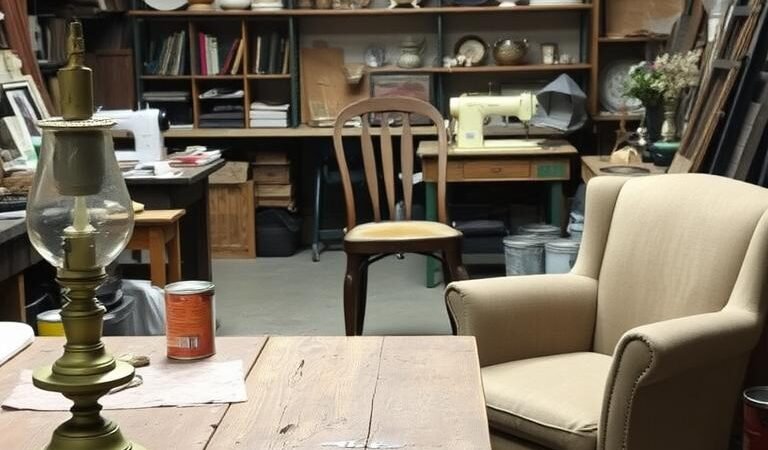In a world where sustainability meets creativity, transforming forgotten pieces into stunning additions for your home has never been more rewarding. According to the Environmental Protection Agency, 12 million tons of furniture waste were generated in 2018, with 9 million tons ending up in landfills. This staggering statistic highlights the urgent need for eco-friendly design solutions.
Whitney Frances Falk, founder of ZZ Driggs, emphasizes that upcycling is not just about practicality—it’s about “doing your part to combat the climate crisis in a way that’s beautiful and feel-good.” Whether you’re a seasoned DIY enthusiast or a beginner, this sustainable practice allows you to breathe new life into worn-out items, turning them into unique, story-filled treasures.
From chalk-painted patinas to reclaimed wood textures, upcycling blends artistry with environmental responsibility. It’s an accessible way to add personality to your space while reducing waste. Ready to explore how you can transform a simple piece into something extraordinary? Let’s dive in.
Key Takeaways
- Upcycling combines creativity with sustainability, offering a practical way to reduce waste.
- In 2018, 12 million tons of furniture waste were generated, with 9 million tons sent to landfills.
- Whitney Frances Falk highlights the beauty and feel-good impact of climate-conscious design.
- This practice is accessible to all skill levels, from beginners to experts.
- Transformative projects, like dresser-to-vanity conversions, add unique character to your home.
Why Upcycling Old Furniture is Worth Your Time
Breathing new life into forgotten pieces is more than a trend—it’s a meaningful way to make a difference. This practice not only reduces waste but also allows you to create unique, personalized decor for your home. Whether you’re a seasoned DIYer or just starting, the benefits are undeniable.
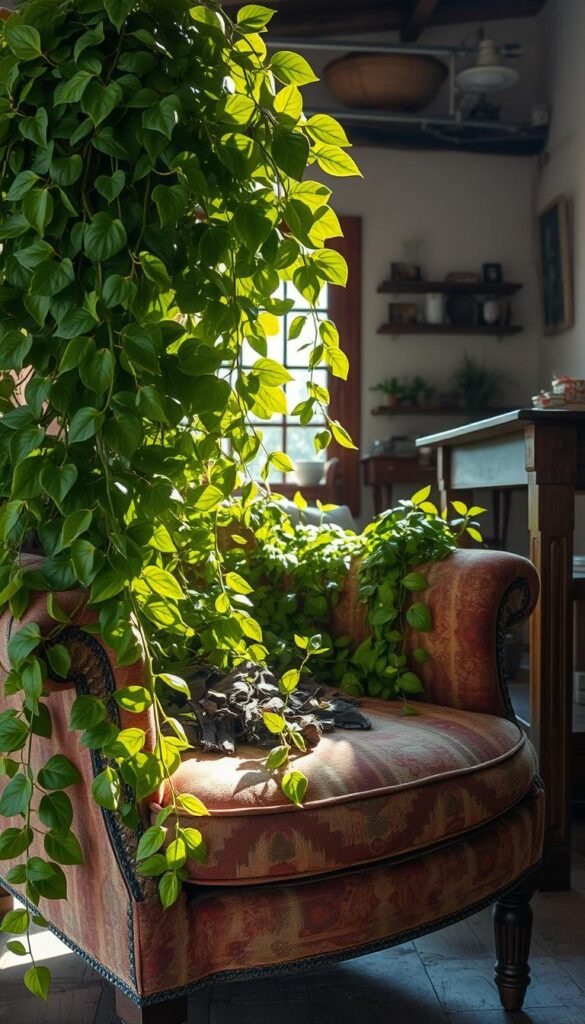
The Environmental Benefits of Upcycling
Did you know that upcycling can reduce furniture landfill waste by 75%? Traditional wood production has a significant carbon footprint, but repurposing existing items minimizes environmental impact. By choosing to revive a piece, you’re contributing to a healthier planet.
For example, a thrifted dresser transformed into a vanity saves resources and reduces emissions. It’s a small step with a big ripple effect.
Cost-Effective Home Decor Solutions
Upcycling is also a budget-friendly way to refresh your space. A $100 thrifted dresser can become a stunning vanity, saving you hundreds compared to retail prices. Platforms like Kaiyo show that upcycled items often increase in resale value, making it a smart investment.
Starter projects, like swapping hardware, require less than $20 and deliver instant results. It’s an affordable way to experiment with your creativity.
Unleashing Your Creativity Through DIY Projects
Hands-on projects nurture both your space and spirit. Architectural Digest’s success stories highlight how simple transformations can lead to stunning results. From chalk-painted patinas to reclaimed wood textures, each piece tells a story.
Upcycling is more than a hobby—it’s a way to express yourself and create something truly one-of-a-kind. Dive into a project today and see where your creativity takes you.
Essential Tools and Materials for Upcycling Furniture
Reviving worn-out pieces starts with the right tools and materials. Whether you’re a beginner or a seasoned DIY enthusiast, having the essentials on hand ensures a smooth and rewarding process. From sanding to painting, each step requires specific supplies to achieve professional-looking results.
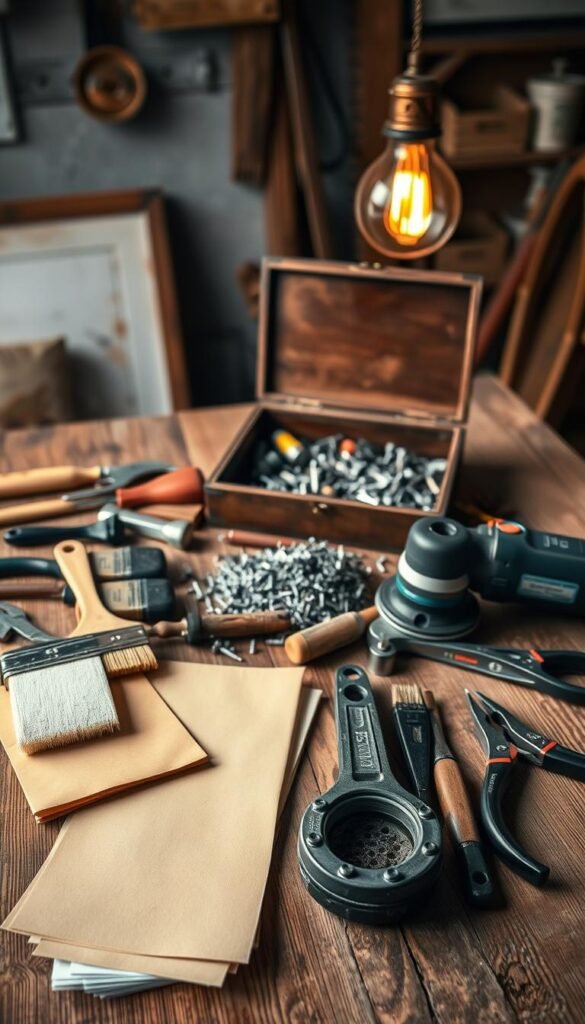
Must-Have Tools for Beginners
Curating a beginner toolkit is the first step. Start with 120-grit sandpaper for smoothing surfaces and angled brushes for precise paint application. Tack cloths are essential for removing dust before applying a coat of paint or stain. These basics set the foundation for any project.
Don’t forget CitriStrip, a highly recommended paint remover for stripping old finishes. It’s eco-friendly and effective, making it a favorite among DIYers. With these tools, you’re ready to tackle your first transformation.
Choosing the Right Paint and Finishes
Paint selection can make or break your project. Milk paint offers a soft, matte finish, while chalk paint provides a velvety texture perfect for rustic looks. For a modern touch, consider powder coating, which costs between $50 and $250 and delivers a durable, crisp finish.
Always prep your surface properly. Degrease the wood and sand along the grain for optimal paint absorption. Skipping wood conditioner is a common pitfall—don’t make this mistake if you want a smooth, professional result.
Where to Find Affordable Furniture to Upcycle
Finding the right pieces doesn’t have to break the bank. Facebook Marketplace is a treasure trove, with high success rates for sourcing affordable items. Regional hotspots like Brooklyn salvage shops and Delaware flea markets are also worth exploring.
When shopping at estate sales, negotiate prices confidently. Look for solid wood furniture with good bones—it’s easier to transform and lasts longer. For more inspiration, check out cozy affordable living room decor ideas to spark your creativity.
Upcycling Old Furniture for a Fresh Look: 7 Creative Ideas
Creative projects can turn overlooked pieces into stunning focal points for any room. With a little effort, you can breathe new life into items that might otherwise be discarded. These ideas blend functionality with artistry, offering unique ways to refresh your home.
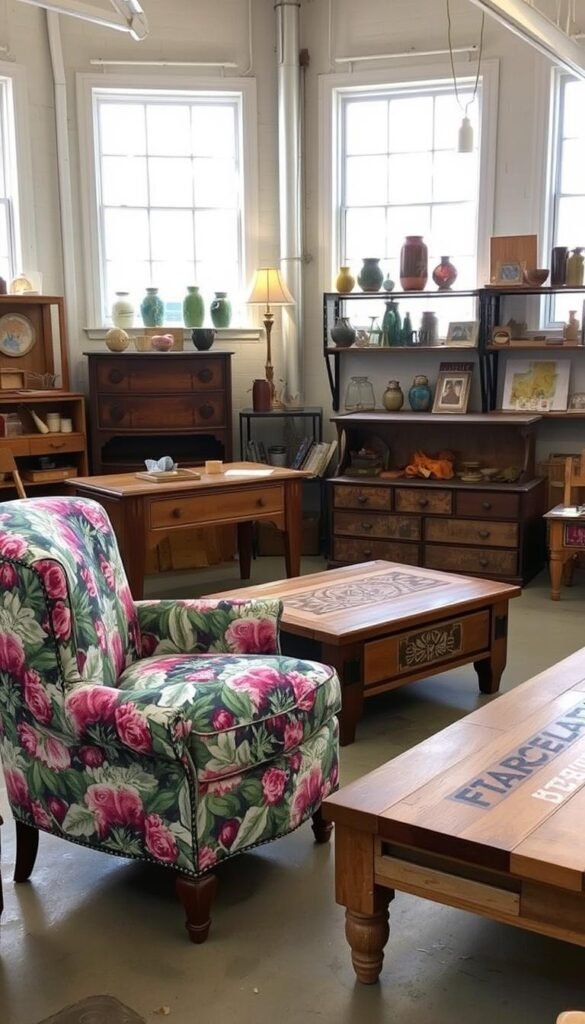
Transform a Dresser into a Stylish Vanity
Turn a thrifted dresser into a chic vanity with these steps. Start by sealing the countertop to protect it from moisture. Integrate plumbing by cutting holes for the sink and faucet. Add a fresh coat of paint for a polished finish.
- Use a lacquered finish for durability.
- Install hand-forged iron pulls for a rustic touch.
- Ensure proper measurements for plumbing integration.
Give Your Coffee Table a Rustic Makeover with Chalk Paint
Revamp your coffee table with chalk paint for a weathered, rustic look. Begin by sanding the surface to remove old finishes. Apply paint using dry-brush techniques to create sunlit patina layers. Seal with a matte finish for durability.
- Choose earthy tones for a natural aesthetic.
- Add decorative legs for extra charm.
- Pair with cozy textiles for a cohesive look.
Turn an Old Door into a Unique Wall Shelf
Repurpose an old door into a functional wall shelf. Cut the door to your desired size and install floating brackets for support. Sand and paint the wood for a fresh, modern appearance. This project adds character to any space.
- Use reclaimed wood for an eco-friendly option.
- Incorporate glass panels for a sleek design.
- Follow safety protocols when cutting materials.
How to Upcycle Furniture for Beginners
Starting your DIY journey with furniture projects can be both rewarding and transformative. With the right techniques, even beginners can achieve professional-looking results. This guide will walk you through simple steps to breathe new life into your pieces.
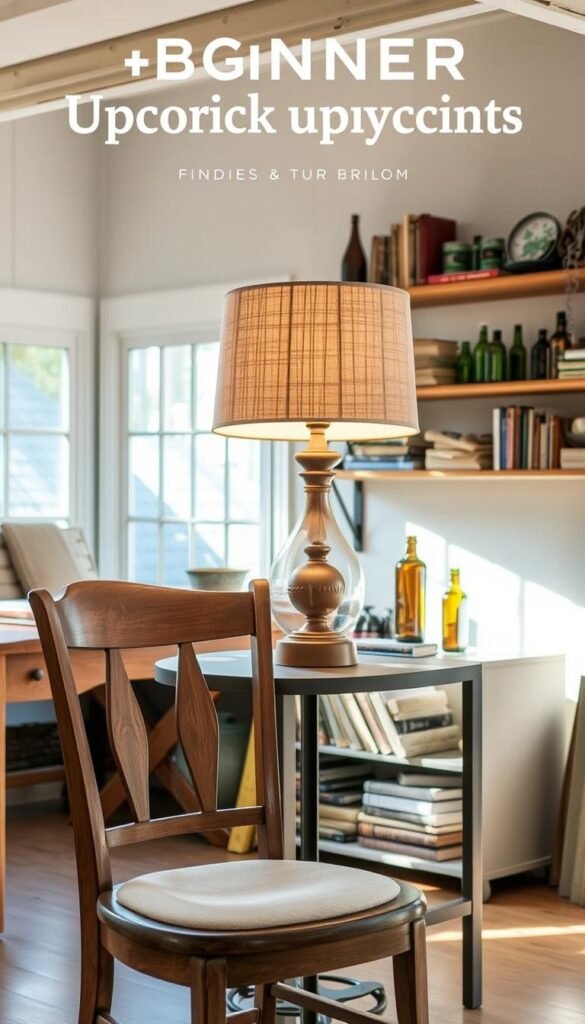
Start with Simple Projects: Painting and Staining
Painting and staining are ideal for beginners. Choose a piece with a smooth surface, like a small table or chair. Use milk paint for a soft finish or chalk paint for a rustic look. For staining, gel stains enhance wood grain, while oil-based options provide durability.
Prep the surface by cleaning it with sugar soap or T.S.P. Sand with 80-grit paper, then move to 120-grit for a smoother finish. Always sand in the direction of the grain to avoid scratches. For more tips, check out this beginner’s guide to upcycling furniture.
Tips for Sanding and Preparing Surfaces
Proper sanding is key to a flawless finish. Start with coarse-grit sandpaper to remove old finishes, then switch to finer grits for smoothness. Use a tack cloth or mineral spirits to remove dust before applying paint or stain.
Common issues like brush marks or uneven absorption can be avoided by prepping the surface thoroughly. Degrease the wood and apply a wood conditioner for better paint adhesion. This ensures a professional-looking coat every time.
Adding Personal Touches with Hardware and Details
Hardware can elevate your piece from ordinary to extraordinary. Swap out dated knobs for Art Deco-inspired pulls or minimalist leather handles. These small changes add personality and style.
Consider textural contrasts, like pairing matte paint with metallic accents. This creates visual interest and makes your piece stand out. With these tips, you’ll transform any item into a unique treasure.
| Project Type | Recommended Paint | Prep Steps |
|---|---|---|
| Painting | Milk Paint | Clean, sand, degrease |
| Staining | Gel Stain | Sand, condition, apply |
| Hardware Update | Art Deco Knobs | Measure, install, finish |
Advanced Upcycling Projects to Elevate Your Space
Take your DIY skills to the next level with advanced projects that redefine your space. These intricate transformations blend artistry with functionality, offering unique ways to enhance your home. From reupholstering chairs to creating custom kitchen islands, these ideas will inspire you to push your creative boundaries.
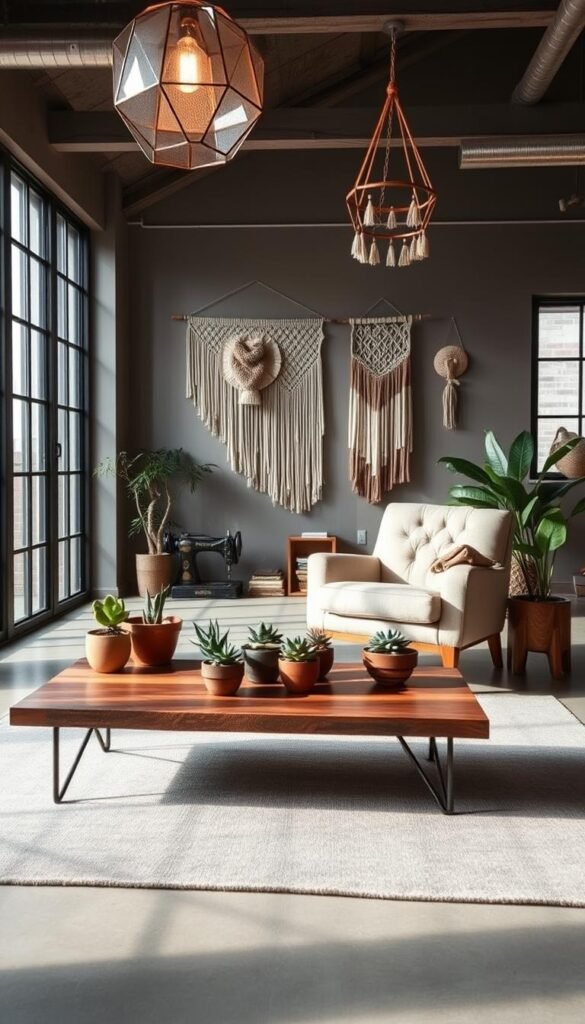
Reupholstering Chairs for a Pop of Color
Reupholstering chairs is a fantastic way to add personality to your home. Start by selecting durable fabrics like Sunbrella for outdoor use or velvet for a luxurious touch. Lucinda Loya’s fringe techniques can add a bohemian flair to your design.
- Use a pneumatic stapler for secure fabric attachment.
- Experiment with bold patterns or textured fabrics for visual interest.
- Incorporate decorative nailheads for a polished finish.
Creating a Kitchen Island from an Old Table
Transform an old table into a functional kitchen island with butcher block attachment methods. Ensure the structure can handle weight ratings of up to 300 lbs for durability. Add storage shelves or drawers for extra utility.
- Reinforce the legs with advanced joinery techniques.
- Apply a lacquered finish for easy cleaning.
- Integrate wheels for mobility and convenience.
Powder Coating Metal Furniture for a Modern Look
Powder coating is a durable and modern way to refresh metal furniture. Professional shops recommend jewel-toned finishes for a striking transformation. This process protects against rust and wear, ensuring longevity.
- Choose liquid metal patinas for a sleek, industrial vibe.
- Pair with buttery leather wraps for a luxe contrast.
- Invest in commercial-grade sanders for a flawless surface.
| Project | Key Tools | Recommended Finishes |
|---|---|---|
| Reupholstering Chairs | Pneumatic Stapler, Fabric Scissors | Velvet, Sunbrella |
| Kitchen Island | Butcher Block, Joinery Tools | Lacquered Finish |
| Powder Coating | Commercial Sanders, Spray Gun | Jewel Tones, Liquid Metal |
Where to Find Inspiration for Your Next Upcycling Project
Finding inspiration for your next project can spark endless creativity and transform your space. Whether you’re looking to refresh a piece or start from scratch, exploring diverse sources can lead to stunning results. From social media to local markets, the possibilities are endless.
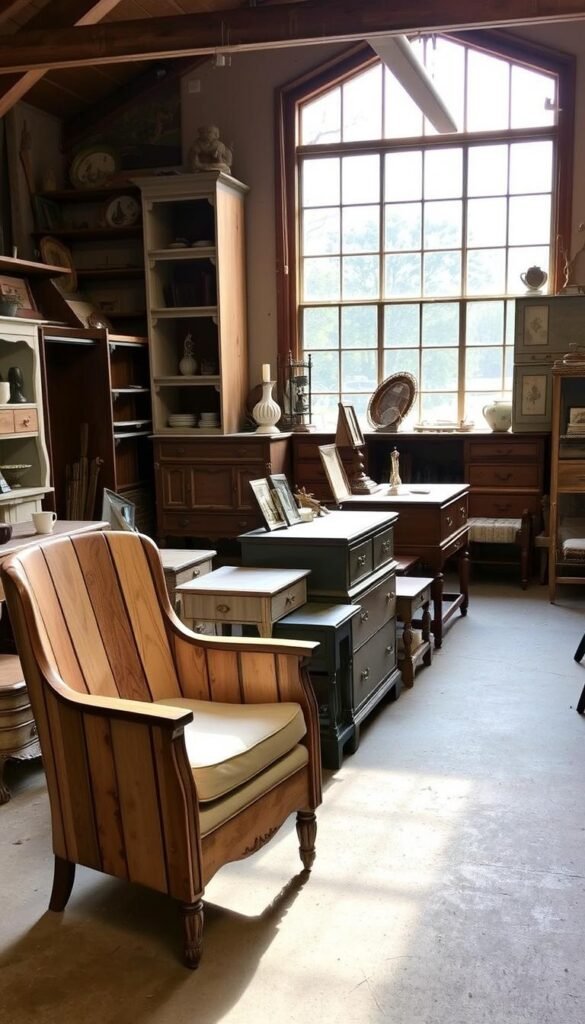
Exploring Social Media for DIY Ideas
Social media platforms like Instagram and TikTok are treasure troves of creative ideas. The hashtag #furnitureflip has garnered over 5 billion views on TikTok, showcasing countless transformations. Follow top accounts like @DIYDesigns and @UpcycleMagic for step-by-step tutorials and fresh concepts.
- Map Instagram’s top upcycling accounts with follower growth metrics.
- Analyze Pinterest trend forecasts for 2024 color palettes.
- Profile influencer collaborations, such as Anthropologie x DIY bloggers.
Visiting Thrift Stores and Flea Markets
Thrift stores and flea markets are goldmines for unique finds. Seasonal buying patterns reveal that late summer and early fall are the best months for quality items. Negotiation scripts can help you secure the best deals on hidden gems.
- Reveal seasonal buying patterns for quality finds.
- Share geotagged hidden gem locations nationwide.
- Use aspirational language like “curate your heirloom collection.”
Learning from Upcycling Experts and Tutorials
Expert guidance can elevate your skills and inspire new projects. Wendy Smit’s washstand revival statistics highlight the transformative power of detailed tutorials. Curate a masterclass list, including upholstery workshops and decoupage seminars, to expand your knowledge.
- Curate masterclass lists for hands-on learning.
- Highlight success stories from upcycling experts.
- Explore advanced techniques like powder coating and reupholstering.
Conclusion
Transforming everyday items into cherished decor is a journey of creativity and purpose. By giving a piece a second chance, you’re contributing to a circular design movement that reduces waste and fosters sustainability. Start small—paint a chair or swap hardware—and gradually tackle more complex projects as your skills grow.
Engage with your community through local repair cafes or online swap groups. These spaces not only inspire but also connect you with like-minded individuals. Remember, every piece has a story—your grandmother’s table awaits its next chapter.
Imagine running your hand over wood grains you’ve revived, feeling the pride of your work. Share your projects with the hashtag #UpcycledHeirlooms and inspire others to join this meaningful way of enhancing their home. Let your creativity shine and breathe new life into the world around you.
